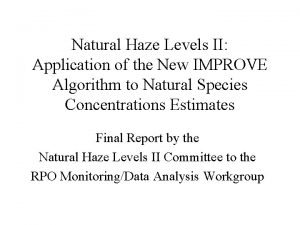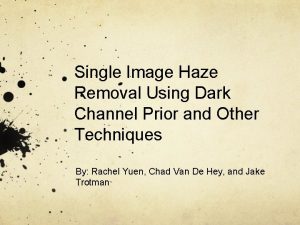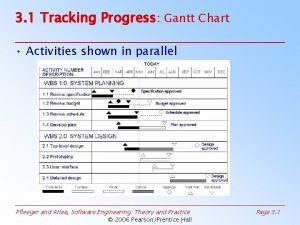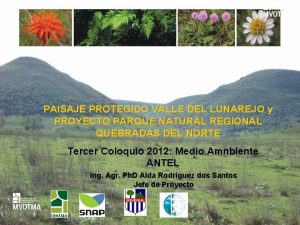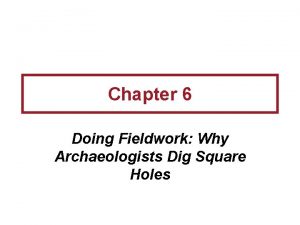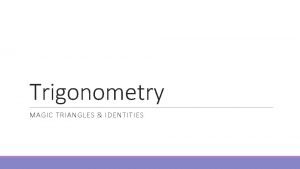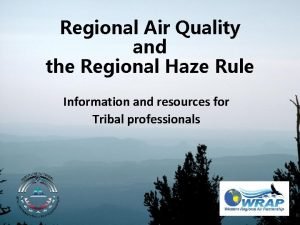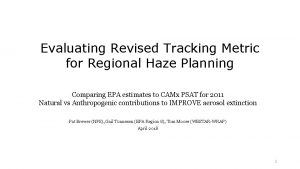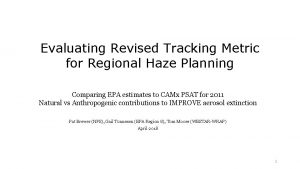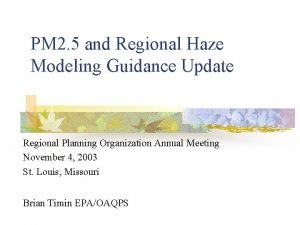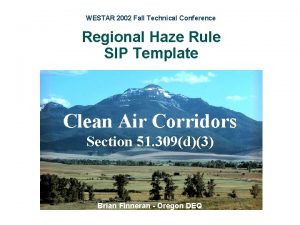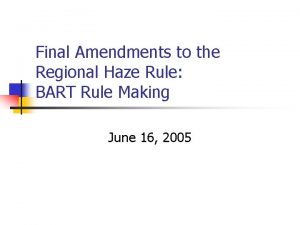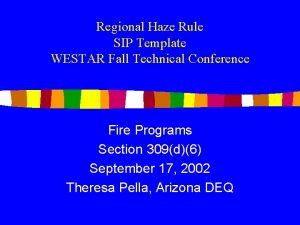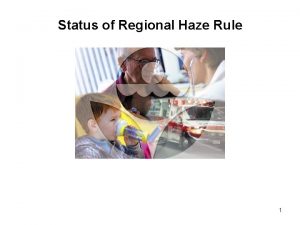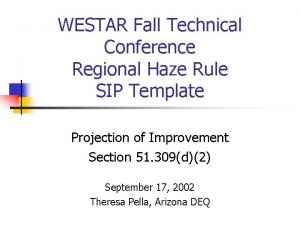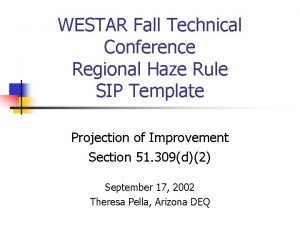Regional Haze Rule Guidance Tracking Progress Natural Levels














- Slides: 14

Regional Haze Rule Guidance: Tracking Progress & Natural Levels Overview of the concepts currently envisioned by EPA working groups by Marc Pitchford; August 2001

Tracking Progress: Regional Haze Rule Constraints • Haze metric – Haziness in deciview units – Determined from aerosol species concentrations – Mean of the 20% best & the 20% worst days each year averaged for 5 years • Progress determination – 5 -year mean best days should not degrade – 5 -year mean worst days should improve at the SIPidentified rate – Baseline period 2000 -2004 is compared with each separate 5 -year period thereafter


Tracking Progress: Guidance Document Topics • Calculation of haze metric – Data requirements • Parameters - IMPROVE species data to determine 6 major aerosol components • Completeness - all 6 components are needed • Substitution for missing components – mean value substitution if demonstrated that the haze values are not affected much – Approach to handle humidity effects on haze • Site-specific monthly adjustment values from historic RH data • Humidity adjustments applied to sulfate & nitrate species only

Tracking Progress: Guidance Document Topics • Calculation of haze metric (continued) – Algorithm to calculate daily extinction -- Algorithm to calculate deciview

Tracking Progress: Guidance Document Topics • Determination of mean of best & worst 20% – Completeness requirements for each year & for five year means – Approaches to deal with completeness deficiencies • Development of the progress goals • Utility of tracking trends in aerosol species trends

Natural Haze Levels Guidance: Regional Haze Rule Constraints • Clean Air Act national goal is to prevent future & remedy existing man-made visibility impairment • Natural haze is what is left when man-made impacts have been eliminated (the goal) – natural levels reflect contemporary conditions & land use patterns, not historic conditions • Reasonable rate of progress must be determined by considering the constant rate needed to bring worst day current conditions to estimated natural levels in 60 years

Natural Haze Levels Guidance: Estimation Approaches • Default approach – Based on natural levels of the six aerosol components estimates for the East & the West, taken from the NAPAP State of Science Report (1990) – Uses same algorithms & humidity adjustments as in the Tracking Progress Guidance – Statistical adjustment of the annual average dv values to the best & worst day values assumes normal distributions of natural conditions with known standard deviation – Default approach has already been applied to every class I area & will be provided in the guidance

Default Approach for Estimating Natural Haze Conditions



Natural Haze Levels Guidance: Estimation Approaches • Refined default approach (must be based on credible technical information) --- Options are: – Improved annual average natural concentration estimates for any of the 6 major aerosol species – Use of temporally varying natural concentrations estimates (e. g. seasonally, by sample period, or for extreme natural events) for any of the 6 aerosol species – All approaches must use the same algorithms for estimating natural levels as used for tracking progress

Natural Haze Levels Guidance • Advantages of the default approach – No states assessment required to adopt – Default values are good enough where current levels are much higher than estimated natural conditions • Advantages of the refined default approach – Permits better accounting of regionally-specific natural sources (e. g. ocean aerosol at coastal sites) – Can account for variations in natural emissions – Incorporates more recent technical information • States can improve their natural haze estimates, as needed, with any of their SIP submittals

Regional Haze Rule Guidance: Tracking Progress & Natural Levels • Public review drafts for both guidance documents are anticipated by early October 2001.
 Natural haze
Natural haze Physical progress and financial progress
Physical progress and financial progress What is the correct equation for cellular respiration?
What is the correct equation for cellular respiration? Single image haze removal using dark channel prior
Single image haze removal using dark channel prior Gantt chart progress tracking
Gantt chart progress tracking Tracking student progress charts
Tracking student progress charts Factors affecting balanced occlusion
Factors affecting balanced occlusion What is the purpose of direct and indirect guidance
What is the purpose of direct and indirect guidance Parque natural regional valle del lunarejo
Parque natural regional valle del lunarejo 3 levels of questions
3 levels of questions Arbitrary vs natural levels archaeology
Arbitrary vs natural levels archaeology Natural hazards vs natural disasters
Natural hazards vs natural disasters Natural income
Natural income Special triangles.
Special triangles. Rearrangement of cosine rule
Rearrangement of cosine rule
